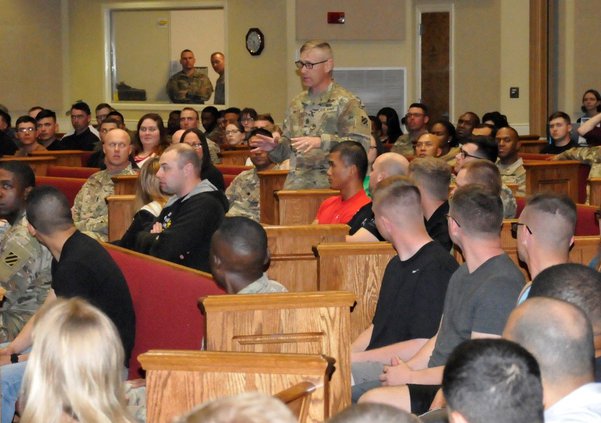(FORT STEWART) – More than 250 community members attended the Fort Stewart Housing town hall meeting, Feb. 27 on Fort Stewart held at the Main Post Chapel.
Maj. Gen. Lee Quintas, as the installation senior commander and 3rd Infantry Division commanding general, opened the event, and explained the town hall was held to answer an Army-wide concern regarding on-post housing and barracks living conditions.
Desiring transparency, the command led off the event with a CBS Evening News story with Chip Reid, who interviewed Secretary of the Army Mark Esper and Sergeant Major of the Army Daniel Dailey, about Army housing conditions. During that interview Esper apologized about the condition of thousands of military houses, which are maintained by private contractors. Esper also said he desired a clear Bill of Rights for housing residents that they can bring to their chain of command.
Quintas brought subject matter experts from the garrison staff, the chain of command and representatives from the private contractor who manages Fort Stewart-Hunter Army Airfield housing - Balfour Beatty Communities.
He explained they could help answer questions and help initiate work-orders following the meeting.
The commander said his intent for the meeting was first to gain consent so the chain of command could conduct assessments of Fort Stewart housing. Second, to explain the inspection process and to explain what they were looking for to help ensure the health and safety of residents. And lastly, to arm community members with knowledge of the work order process and encourage attendees to be part of the feedback process.
The 3rd ID senior enlisted leader, Command Sgt. Maj. Michael J. Coffey, an on-post resident himself, said company commanders and first sergeants would help with the health and safety inspections, but they needed help, noting no soldier should live in conditions that are unhealthy or unsafe.
“We need you as tenants of Fort Stewart and Hunter Army Airfield, to get involved in the process,” Coffey said.
To help community members understand what an assessment looked like, Balfour Beatty Communities produced a what-to-look for video, conducting a walk-through of a house on Stewart.
Health and safety tips:
-Drinking water. Check the color.
-Cabinets and pantries. Check for ventilation.
-Doors to rooms, closets, cabinets and pantries. Make sure doors open easily.
-Lighting. Ensure they work and provide adequate visibility.
-Bathrooms. Check for discolored walls due to water damage or mold; and ventilation.
-Walls throughout the house. Look for paint cracking, chipping, or pealing. For houses constructed prior to 1978 this issues elevates to urgent level, as lead based paint was commonly used then.
-Smoke detectors and firestop. Make sure they are present and functional. (The video noted the firestops are normally founder under the stove’s ventilation fan/hood.
-Child fall sticker. Make sure the stickers are present for two story dwellings.
-Pest indicators. Normally found in corners or tight spaces.
The garrison commander, Col. Jason Wolter, then walked attendees through the reporting process. He noted access to reporting could be found using the installation’s social media platforms, website and included a hotline, (912) 767-5770. He said there are dedicated response times, depending on the severity of the issue. Wolter explained how and where to submit a work order, the time standards for the work order and how to engage quality control.
Housing response standards:
-Emergencies during duty days, 30 minutes or less; one-hour for non-duty days.
-Urgent, four hours.
-Routine, 48 hours.
For Barracks, he noted three ways for reporting issues, the Demand Maintenance Order (767-2883) online at https://home.army.mil/stewart/indexp.php/contact/service-order-request; the Area Barracks Management Team; and the chain of command.
Barracks response standards:
-Emergency, 1 hours
-Urgent, 7 days
-Routine, 30 days
Balfour Beatty Communities has a three-step process for reporting issue, illustrated on the Fort Stewart website at https://home.army.mil/stewart/index.php/housing. First, contact the local management or maintenance team; second, if you are not satisfied or your request is incomplete, contact management. Third, if the issue remains unresolved, contact Army housing.
Following the briefing, the command opened the town hall up to questions and concerns. One major concern was older housing, especially those built prior to 1978 which may have lead based paint.
Balfour Beaty Communities’ Regional Director, Bo Letnaunchyn, said they were aware of concerns, but noted while about 40 percent of the on-post houses were newer homes, encapsulating lead based paint mitigates the threat. He said if community members saw indicators of paint cracking, chipping or peeling, the work order would be escalated to address the issue.
Many questions revolved around a lack of responsiveness or sense of urgency. To address the concerns BBC established on-site stations at the back of the town hall to immediately record and follow-up on concerns.
Another town hall was held earlier, Feb. 27, on Hunter Army Airfield at the Hunter Chapel with about 75 community members in attendance. They expressed similar concerns to those heard at Fort Stewart.

